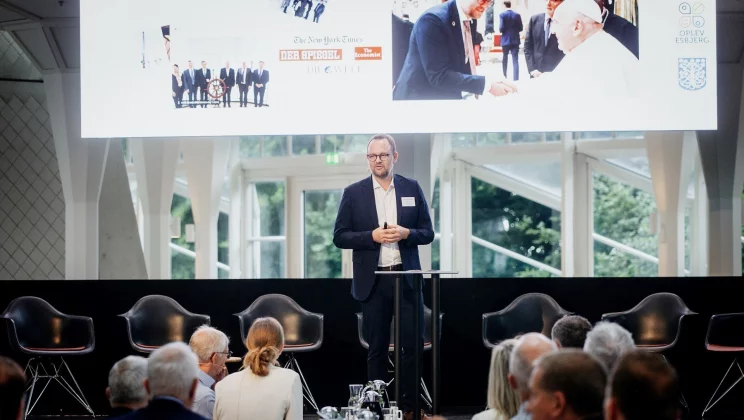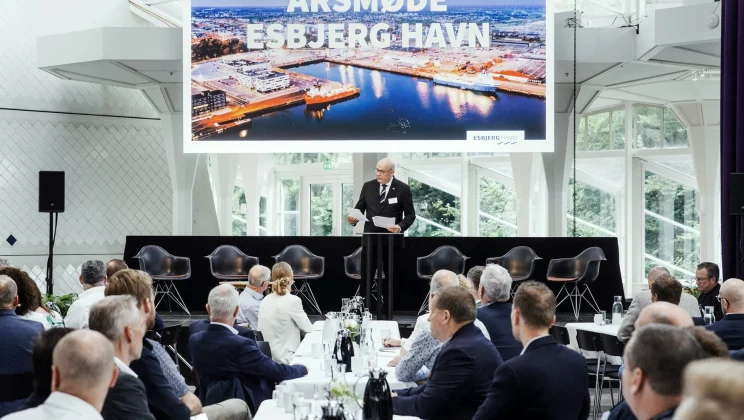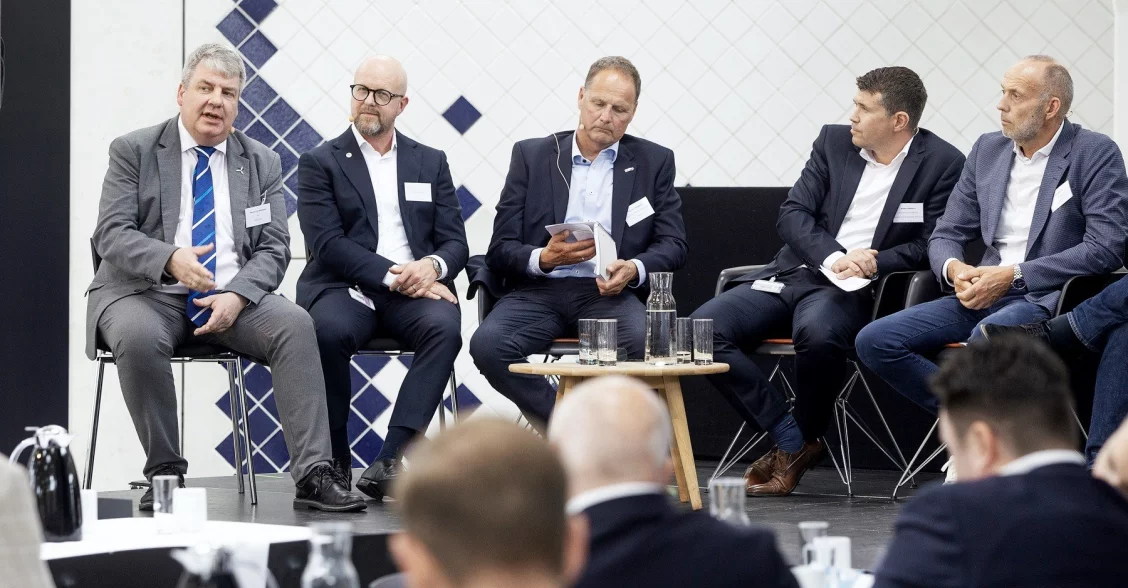‘Ask us anything’ was one of the items of the agenda at Port Esbjerg’s Annual Meeting. This resulted for the most part in praise, although many of the attendees were concerned about the shortage of space at the port. Expansion of the port was discussed, and the chairman thanked the businesses for their exceptional efforts in earning the port a place in the world elite.
Guests were welcomed with pleasant tunes from the moment they entered the Esbjerg concert hall for Port Esbjerg’s Annual Meeting in late May.
A pianist was seated at the grand piano in the entrance hall to set the tone as more than a hundred local business leaders, politicians and other interested parties arrived to learn about the past year at the port and the perspectives for the coming years.
The good atmosphere created by the music filled the venue throughout the event, even though the stage had been set for debate.
The members of Port Esbjerg’s Advisory Board, consisting mainly of representatives of businesses located at the port, were lined up on stage and interviewed by journalist Bo Bechsgaard from the national broadcasting station DR Syd. Bechsgaard has covered the port for a number of years, and he tried to encourage the attendees to criticise the management.
“Aren’t the port’s prices too high?” Bechsgaard asked, among other things, and he received the following reply:
“I actually believe that we get good value for our money,” said Nicolaj Vejlgaard, Senior Vice President of Semco Maritime, and his opinion seemed to find favour with several other members of the audience.
“But in the past, you have stood with pitchforks on the quay. The port makes millions in profit, you know,” said Bechsgaard.
Henrik Otto, CEO of Niels Winther Shipping and Scandinavian Auto Logistics, replied:
“Yes, but I don’t mind that the port makes a profit as long as it is reinvested in the port. Of course, we would like lower prices. This would also benefit the port, because we would become more competitive. But the port invests in the future, and that makes sense.”
Søren Stougaard, Chairman of the Advisory Board, was also very sympathetic:
“I’ve not always been completely satisfied, but the chairman and the management of the port have made a big shift in a positive direction.”
Businesses require more space
There is no doubt, however, that there are challenges. A recurring issue in the debate was the shortage of space. Without more space, there will be no new business.
The 4,500,000 sqm that make up the port are not enough. Capacity is scarce as it is, because wind turbine blades become longer, the fairway is being deepened to allow new types of vessels to enter the port, and more road networks are needed. In other words, expanding the port is a matter of urgency to keep up with the fast pace.
One attendee pointed out that there are no actual installation ports in Germany so, for that reason alone, Port Esbjerg needs more space.
Bo Bechsgaard asked if a dry port was part of the solution. Port Esbjerg CEO Dennis Jul Pedersen confirmed that it was.
He revealed that the port had launched a project involving a local site for a dry port area.
“We have begun the process of applying for permission to expand with an area that doesn’t need to be close to the quay – though as close to the port as possible. The timeframe is just over two years,” he said.

Mayor Jesper Frost experiences increased international focus and recognition of the port's activities when he travels outside the country's borders.
The mayor: The world looks to us for inspiration
Mayor Jesper Frost Rasmussen also took to the stage and presented a list of names of new businesses that have set up shop in the municipality of Esbjerg and at the port in the past year. Ecomar Propulsion, Moss and Høst were among the many new names.
Just over a week before the Annual Meeting, Frost Rasmussen participated in a climate conference for C40 cities around the world, attended by the mayors of London and Paris and the governor of California.
“The world looks to us for inspiration,” Frost Rasmussen said, illustrating his statement by showing a photo from the conference that was held in the Vatican City, where Frost Rasmussen met the Pope.
Frost Rasmussen was the only Danish representative.
“This demonstrates that we have made a difference. We and you who are here today represent and deliver something for the green transition that the rest of the world is looking for. Many talk the talk, but very few walk the walk.”
Frost Rasmussen mentioned that the district heating system of the future will also be found at the port when the world’s largest seawater heat pump is commissioned later this year. The project has attracted delegations from all over the world and is admired for its innovation and perspective on the future.

"We have raised our voices in the right places, and they have been listened to." These were the words of chairman Søren Gade, who experiences an EU that is increasingly agile and ready to act.
Praise from the chairman
Chairman Søren Gade delivered his third speech as chairman of Port Esbjerg and began by praising the businesses at the port.
“Without you, we could never have achieved the unique success that Port Esbjerg is experiencing these years. We owe you a big thank you for all your hard work. With your help, we have continued to build on the strong international position that our port has achieved. Without you, we wouldn’t be home to thousands of jobs or help drive change in Esbjerg, Denmark and the rest of the world. I very much appreciate our good and highly constructive partnership. Thank you everybody!” he said.
He believes that the citizens of Esbjerg might as well get used to having the eyes of the world resting on them.
“In a world of growing political uncertainty and the disturbing events we have witnessed in recent years, we need to strengthen Europe’s security. Both security of supply and energy.
In this respect, Esbjerg now also plays a role in supporting the NATO partnership by deepening the fairway to accommodate vessels carrying NATO equipment,” he said.
At the same time, Gade believes that the EU has begun acting in a more agile fashion than previously. It has set up support schemes aimed at accelerating the pace of the green transition, focusing particularly on the ports. A resolute EU is a prerequisite for a successful green transition.
“We have voiced our concerns in the right places, and we have been heard.”
Port Esbjerg has also forged even closer ties with the EU through, for example, the collaboration on the Offshore Wind Ports Platform under the auspices of WindEurope, in which ports are now also at the top of the agenda.
“We have also noticed that there is now wide recognition of the need to invest in the industry and to support the value chain to accelerate the pace. The ports are generally central to these discussions,” he said.
About a week before the Annual Meeting, Siemens Gamesa had received a commitment of DKK 375 million to establish and upscale the production of wind turbines at Port Esbjerg.
“This is proof that the trend is continuing. We’re ready to do our part, and the regulatory and administrative constraints that delay and impede the green transition in Europe are easing,” said Gade.
Port Esbjerg is ready to shoulder its responsibility – both for the green transition and for the security of Europe’s citizens.
“The green transition and NATO can count on us here in Esbjerg,” he said.
Go to overview

